Good news from deep space: NASA has reestablished contact with the ailing Voyager 1 spacecraft, even though the Voyager is 24 billion kilometers and 22 light-hours away from its terrestrial programmers. The nearly half-century old space probe survives… at least for the moment.
Young people may be astonished to discover that it was at one time possible to build devices that continued functioning for decades. In fact, cunning design, high quality materials, and luck can enable human creations to survive not just decades but long after their creators have died. In some cases, such as Roman roads1, they have outlived the civilizations that created them.
Unsurprisingly, SF authors are quite fond of the idea of durable artifacts. No need to explain how their setting’s civilizations created such; those precursors are now conveniently vanished. As long as one understands what something does, it’s not necessary to understand how it works if one just wants to use it2.
Consider these five vintage works of SF that involve technological relics.
Galactic Derelict by Andre Norton (1959)
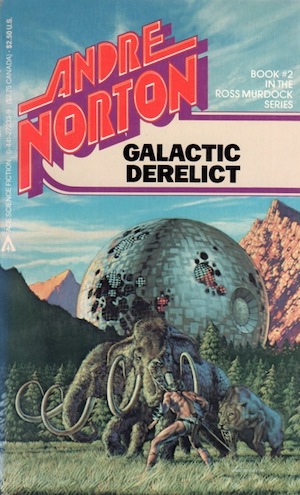
Fifteen thousand years ago many alien starships visited Earth. Many never left. The passage of millennia has reduced the starships to enigmatic fragments. However, both Americans and their Soviet rivals have developed time machines that can retrieve alien artifacts from the distant past.
A series of mishaps traps four Americans (Travis, Ross, Ashe, and Renfry) on what turns out to be a fully functional derelict. Slave to its programming, the craft bears the four men along an ancient trade route. The reluctant passengers find that the aliens who built the ship are long gone, but many of the dead aliens’ artifacts remain perfectly functional.
Often SF authors imagine that working alien relics will turn out to be doomsday devices. Norton’s imagination is kinder: the quartet survive because the alien refueling infrastructure is surprisingly durable.
Hiero’s Journey by Sterling E. Lanier (1973)
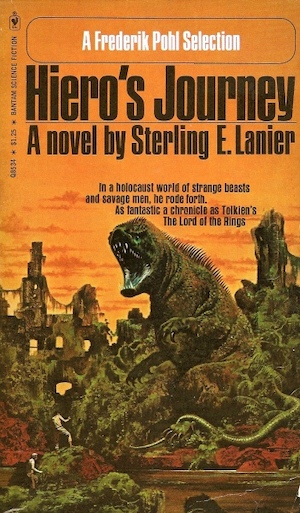
Long after atomic doom scoured western civilization from the face of the planet, the Metz Republic and the Otwah League prevail under the benevolent guidance of the Church Universal. The Church is reaching the limits of its clerk-and-filing-cabinet-based information technology. Pre-apocalyptic technology might solve their problems.
Accompanied by an intelligent bear and a telepathic war-moose, Secondary Priest-Exorcist, Primary Rover, and Senior Killman Hiero Desteen is dispatched to the radioactive wastelands once known as the United States of America. Desteen’s goal? A legendary artifact known as a “computer.”
Lanier demonstrates considerable faith in the durability of modern-day technology. The travelers need only hit an on-switch for pre-war machines to activate. Impressive, considering that the novel is set in the year 7476 AD.
Strata by Terry Pratchett (1981)
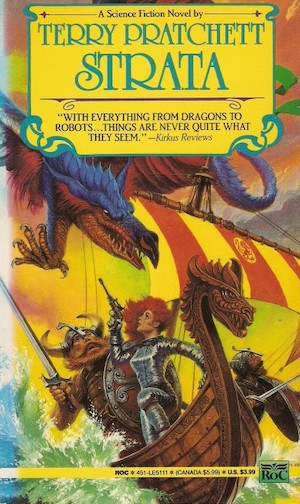
Enigmatic Jago Jalo returns from a thousand-year relativistic journey bearing a potentially valuable secret. Jago recruits planetary engineer Kin Arad to further explore Jago’s discovery, with an eye to exploitation. The discovery? A clearly artificial flat Earth.
Ancient alien relics are not novel. Kin’s profession depends in part on reverse engineering the technology left behind by the alien “Spindle Kings.” Nevertheless, this discworld is an audacious achievement… one whose service life will soon end, and whose inhabitants have need of a person like Kin.
A note to Pratchett fans who have not read Strata: while this novel is by Pratchett and does feature a discworld, this Pratchett discworld is not the Discworld for which Pratchett is famous.
Skeen’s Leap by Jo Clayton (1986)
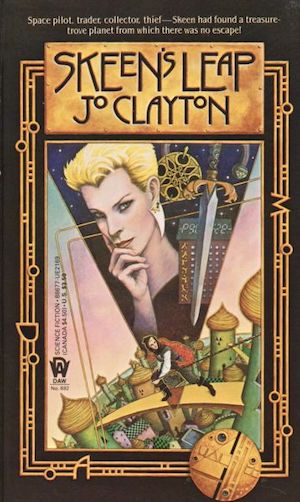
Skeen makes her living facilitating the repurposing of durable relics left by vanished civilizations. Authorities call this “grave robbing,” and would happily imprison Skeen if they could only get their hands on her. Heretofore, Skeen has been able to flee arrest. Now she is marooned on the backwater planet Kildun Aalda. Capture seems only a matter of time.
Fortuitously, the alien Ykx left in their wake some interdimensional gates. Skeen need only step through one to escape Kildun Aalda’s police. There is a catch. This gate turns out to be one way and while the gates are durable, the same cannot be said of the advanced technology previous gate users carried with them. Skeen escaped a backwater world to arrive on a barbarian planet devoid of even the most primitive starship. Skeen’s new home does, however, enjoy a proliferation of cutthroat politics.
I suspect any setting where functioning alien relics are a thing has developed protocols for testing mysterious gates. Given her profession, Skeen is no doubt familiar with such protocols. I’m guessing she eschewed proper procedure because she was more afraid of the cops than of whatever was on the other side of the gate.
The Dragon Never Sleeps by Glen Cook (1988)
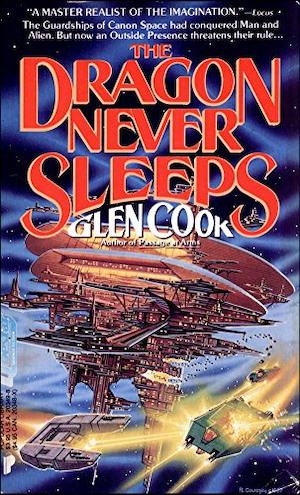
Having stumbled across Canon Space, humans wasted no time using its superluminal networks to conquer every alien civilization within reach. In the millennia since the conquest, vast Guardships have kept the human boot firmly on alien throats. However, humans are not immune to entropy. Despite their best efforts to enforce stasis, change is coming.
Humans could not have established their empire had not an alien race first built what humans assumed was an interstellar portal network. Interestingly, although the alien creation can be used that way, that’s not what it was made for. Misusing it degrades the network…with unexpected consequences.
There are so many works I could have mentioned—Pohl’s Gateway, George O. Smith’s “Lost Art,” Simak’s Way Station—but didn’t. No doubt I missed some of your favourite works about tech relics. If so, please regale us with titles and authors in comments below.
- There is of course a considerable survivorship bias. We’re impressed by the craftmanship of a functioning 2000-year-old Roman road. We do not even think about all the shoddy Roman roads that vanished soon after they were built.
- When it comes to stupendously durable cursed items, you don’t need to know how ancient Egyptian magic worked to know that waking up an angry, immortal, nigh-godlike monster bent on global destruction is probably a bad idea.















Is it just me, or is the actual article missing? I’m just seeing the footnotes…
Whoops. The article seems to be below the comments… I blame CSS.
Looks like the CSS got sorted.
Not just you. The article seems to be under the comments.
Did subscribe stop working?
[edited]
Well, it works in chrome, so I can subscribe using my phone but not my laptop.
So happy to see Hiero’s Journey on here. It was the first thing that sprang to mind when I saw the title of the article. It’s far from a perfect book, but it’s great fun and quite memorable. Nothing like a Metis guy riding his domesticated moose through a now-tropical northern Ontario having psychic/physical battles with weird villains and super-sized creatures of all sorts!
Thanks for this one, James.
A warning for those who decide to hunt down Hiero’s Journey – note that it is the first book of a trilogy. The second book (The Unforsaken Hiero) ends with a cliffhanger, and Sterling Lanier was never able to write the third book. He died in 2007, ending any chance of it ever appearing.
Somewhere previously in a discussion of the final book, it appeared that there was a relative with notes, herself a writer, who was considering the final. Maybe a year or more ago.
There an Adrian Tchaikovsky, but since the ancient tech is the big reveal, I shan’t say which.
There’s a few by Tchaikovsky; besides the one you’re thinking of, there’s the Final Architecture series. In The Expert System’s Brother and Elder Race the ancient tech is human, because they’re lost colony worlds. Children of Time is also kind of a story about discovering ancient technology, only the ancient technology is the protagonists for most of the book.
William Gibson’s short story Hinterlands comes to mind. Great story, though kind of a downer
Anne McCaffrey’s later Pern books have an AI system being rediscovered. Since it’s McCaffrey the system is helpful rather than all-conquering and sociopathic.
I forget if Isaac Asimov was alive and reading to approve of the AI on Pern, but I like to think that he would. I also like to think that today’s Asimov fans will find ways to steer 2024’s AI into being humane and not like it is now.
Its been a gazillion years since I read a Pern book, but that’s the first thing that sprang to mind.

That and Motel of the Mysteries, even though that’s not lost technology, more like odd archeology
Although the toilet might still work- even if the “sanitized for your protection” strip doesn’t
Woody Allen’s Sleeper has the thousand year old Volkswagen with the key left in the ignition that starts right up.
On a more serious note, Jack McDevitt’s Priscilla Hutchins series has numerous encounters with ancient alien technology.
Other examples of Andre Norton novels featuring “ancient tech” are Sargasso of Space (first in the Solar Queen series) and the Zero Stone/Uncharted Stars duology. These are relics of the “Forerunners,” a long-vanished interstellar empire of immense power that seemed to have destroyed itself in a devastating war in the distant past.
also ‘Merlin’s Mirror’ :D
And Judgement on Janus.
Melissa Scott’s Finders is about salvagers finding remnants of ancient technology from much more advanced civilizations which fell catastrophically. The most common finds are essentially power charges, but the more rare finds can be almost anything. Finders succeeds on multiple levels, with worldbuilding on a grand scale, characters you care about, and a thrilling story. Rediscovering ancient technology is one of my favorite sub-genres and Finders is my favorite of all that I have read. I’d love for more people to read it so we could talk about it.
“Lost Art” was my first thought even though it’s not a novel; Galactic Derelict may be the first Norton I read, and is still one of my favorites. I’m curious about how Way Station would qualify, as it involves secretly delivering current tech to a backward planet (Earth) rather than any discovery.
In Norton’s Ice Crown, the tech may not be that old, but none of the locals realize it’s actually working until an ?anthropology? team shows up from offworld. Norton did a lot of stories set in past ruins; Lord of Thunder is the only other one I recall in which tech is found and is still working.
At the end of Heinlein’s Farmer in the Sky, alien tech (with at least one piece of useful equipment still working) is discovered by colonists on Ganymede. ISTR there’s also alien tech discovered in John Barnes’s A Million Open Doors just before the revolution but my memory is uncertain.
Found the Barnes; there are artifacts, but no tech.
Here are a few classics:
In the later Foundation stories, Asimov reveals that R. Daneel Olivaw is still functioning and has been secretly guiding the fate of humanity all these millenia.
In Clarke’s Against the Fall of Night (or its longer version, The City and the Stars), the protagonist starts in a technological city still functioning after millions of years, where (as far as they know) humanity has isolated itself all this time. Later, he finds some technology still functioning from before the founding of the city, which explains why the residents of the city hid there.
In The Time Machine, the Time Traveller finds in a museum an 800,000 year old box of matches that still work … if you’ve kept the box.
In At The Mountains of Madness, it is revealed that the shoggoths are the result of biological engineering by the Elder Race.
And, of course, Jack McDevitt has practially made a career out of ancient artifacts, many of which still function.
Larry Niven has a ton of these, mostly involving technology sealed in stasis from a billion-year-old war between the Thrintun “Slavers” and the rebel Tnuctipun technologists; on one occasion (World of Ptaavs</em[,also The Asteroid Queen, but that was a Man-Kzin Wars shared universe book written by IIRC Dean Ing) the artifact was a life-support system with a live Thrint inside. Probably the most famous is “The Soft Weapon,” about a shape changing weapon, which has the dubious distinction of inserting the Kzinti into conflict with the Federation because Niven couldn’t be bothered properly adapting it for the Star Trek Animated Series episode “The Slaver Weapon”. Why Roddenberry or someone on the Trek end didn’t swap in Klingons instead I will never understand.
Pip and Flinx from Alan Dean Foster’s eponymous series encounter several, including The Tar-Aiym Krang, an ancient device and the title of the third (iirc) book.
Adrian Tchaikovsky’s Final Architecture series (not the one already mentioned) involves vastly powerful space creatures that destroy inhabited planets unless they have precursor artifacts on them; moving said artifacts removes the protection. Figuring out why any of this is the case is the thrust of the story.
Eric Flint’s Boundary starts with a paleontologist digging up an alien fissil right around the KT Boundary, and later there’s a base on Mars and a couple sequels I never read.
You could easily have filled the whole column with ancient artifacts that are interstellar transport networks, or used as such by humans; in addition to the ones you mentioned, there’s Timothy Zahn’s Quadrail series, Tim Pratt’s Axiom series, and another couple I read relatively recently but now can’t remember. Maybe later.
If you are talking about Niven, you can’t forget the big elephant in the room: Ringworld.
Moving over to TV, there’s the Stargate franchise, which demystifies the sensawunda of the original movie but in interesting ways–? Like, maybe we shouldn’t use the instantaneous transportation network without the original user terminal. And even though the original builders made the navigation system as simple as possible, they did not account for interstellar drift. And the power supply of something that can transport you over light years instantaneously is probably very dangerous. And so forth.
Point of order: the original builders did account for interstellar drift if you had a functioning DHD. The system propagated updates to the coordinate tables as needed. Earth just didn’t have a DHD to update the Stargate’s coordinate tables.
Having looked at the fan page that tries to explain Stargate dialling, I’ve decided to believe that the codes are spatial according to the locations of stars when the gates were installed, but that inside the Stargate, managed by the DHD, these are substituted with more exact physical location. It’s known that another Stargate operating on Earth interferes with Stargate Command access and an incoming wormhole foes there instead, so it’s not that precise, Earth moves every day after all. But someone remarked on Reddit that putting a gate at Alpha Centauri would also interfere unless the dialling system was more refined.
There are six spatial codes plus a “point of origin”, which seems unnecessary. Apparently it was the thing in the “Stargate” film that they had to figure out before dialling worked at all. I’m thinking of headcanoning that as being a local administrator’s authorisation code to use the Stargate, hardly a secure one but if pressing the Earth button to leave Earth means that you’re declaring that you are travelling by the will or consent of the Earth System Lord, then people who might misuse the gate would be discouraged from doing so. Or it may be a security feature currently disconnected, along with handprint recognition.
So basically it is like 2024 telephone dialling, which includes historic physical routing and other historical dimensions but now doesn’t have to be physical at all, with the exception of international dialling by country code – and even there, you can take a cellphone overseas and your home country number can work, although it may be extremely expensive for you or for your friends.
This is true.
ISFDB has The Tar-Aiym Krang as first by publishing order, second by internal chronology (For Love of Mother-Not is first).
Addendum: Ringworld is of course the most famous Niven story with ancient tech, but that’s not Slaver stuff, which is why I forgot it earlier
I would add the Well of Souls series by Jack L. Chalker. Space archeologists reactivate the computers of a long dead race. Never a good idea.
Not for the first time, I’ll express my admiration for C.J. Cherryh’s Union for discovering ancient spacetime gates whose handy use for instant transport and occasional time travel had destroyed two separate interstellar civilizations, and dispatching a one-way expedition to shut the whole thing down with extreme prejudice. “Gate of Ivrel” and its sequels present the most sensible response to that sort of thing I recall ever seeing.
Granted, as of that book the expedition has been whittled down to one second-generation member imprudently carrying a WMD disguised as a sword with a how-to manual engraved on it, suggesting that the whole plan may yet end in tears. But it’s a solid effort, and none of the planets we see making use of the Gates suggest the basic idea of killing them with fire was wrong. (Though their dependence and her monomania does make Morgaine and her mission less than universally popular.)
Of course there’s nothing like ancient tech from the Transcend to really alter the course of a civilization, or of a significant portion of the galaxy. Sometimes you should just leave old cookbooks alone.
Then there’s the thawed out domed cities of After Worlds Collide by Balmer and Wylie. They somehow survived being frozen solid in interstellar space and are still mostly functional after who knows how many millennia or eons!
One for the pile: Across a Billion Years by Robert Silverberg. I know it’s pretty much lightweight YA style stuff, but I read the crap out of it when I was a kid.
Also, Alastair Reynold’s Merlin series. The ancient tech in this case are the space “lanes” that allow a craft to travel at a substantial fraction of the speed of light without having to worry about reaction mass.
Across a Billion Years is excellent.
One of my favorite books, and my favorite of John Stith’s work, is Reunion on Neverend. Ancient high-tech portals, a secret agent at his high-school reunion, hijinks ensue!
“The Church is reaching the limits of its clerk-and-filing-cabinet-based information technology.”
If electronic digital technology is beyond their power to recreate, they might perhaps find useful the concept of “Edge Notch Cards”, a pre-digital method of creating sortable databases:
https://www.projectrho.com/public_html/rocket/astrodeck.php#id–Computing–Edge-notched_card
The (sad?) thing is the prize they find is a tutorial / manual on analog computer operation, not really useful for processing data.
‘Ringworld’ springs to mind as a big-scale example. Similarly the ancient tech discovered in ‘The Expanse’ tales. On a smaller scale the alien starship in ‘Broken Angels’ is a reasonable, passive example.
There’s a lot of this Macguffin out there.
Strata is also a parody of Niven’s Ringworld, but don’t let that scare you away from reading it.
A few decades prior to the first chapter in A Canticle for Leibowitz, the Venerable Boedulus discovered a buried “missile-launching control” during his expedition searching for relics from before the Flame Deluge, and it still worked, sort of. The resulting large lake was discovered by a subsequent Leibowitzian Order expedition sent to find Boedulus’s party.
@@@@@ Raskos Along with the myth of “Bo’dollos, the giant catfish who lived in the deep.”
In Edgar Pangborn’s The Company of Glory, we see a toilet that’s repurposed as a planter. (growing marijuana, I believe) A few of our protagonists are old enough to remember the original use and feel wistful.
I’m surprised no one’s mentioned the Gateway books yet.
Yeah. James even said he didn’t mention Gateway.
And of course I read the excellent “Galactic Derelict” by Andre Norton.
And this list desperately needs:
1. the awesome “Mutineer’s Moon” by David Weber
2. “Ancient Shores” by Jack McDevitt
3. The Expanse series by James S. A. Corey
Vault of Ages, Poul Anderson. Galactic Derelict was actually a sequel to an earlier, and IMO better, book, Time Trader.
A matter of taste; Galactic Derelict was (among other features) one of the first novels to feature a Native American as a character rather than a stereotype.
Thomas Harlan’s In the Time of the Sixth Sun trilogy is centered on a gifted archaeologist investigating alien artifacts. It is set in an alternate history where Aztecs conquered the Earth and now rule an interstellar empire. Which is very small compared to nearby alien empires. Interstellar politics is fractious and very high stakes. The first book, Wasteland of Flint, is enigmatic and moody. The second book, House of Reeds, is a wild ride. The third book, Land of the Dead, turns it up to eleventy, a setting that is normally found only on amps of alien manufacture.
“A question. Since before your sun burned hot in space and before your race was born, I have awaited a question.”
An interesting counterpoint to these stories is Roadside Picnic, where the advanced technology is essentially the leftovers of an alien picnic outing, and largely incomprehensible and dangerous to humans.
Fred Saberhagen’s Berserker stories are about ancient technology discovering us. As the title implies, it goes badly
STRATA was the first Pratchett I read, and the only one for a LONG time. I had stopped ready fantasy, and didn’t want to get started on a long series, but someone in our book club finally got me to read GOING POSTAL and now I’m slowly working my way through Discworld
I’ve been thinking about revisiting STRATA to see how it held up.
Maybe Sheri Tepper’s Raising the Stones?
I guess maybe there’s a long debate to be dusted off about what counts as a technology above and beyond device-type artefacts.
“The Expanse”: novels and tv series (that follows the book series very closely). Interestingly enough, I liked the last three books in the series even more than the first six.
There’s also the Quintaglio Ascension trilogy by Robert J. Sawyer, where the inhabitants of a moon orbiting a gas giant find a number of ancient artifacts and also a spaceship from another world.
Well, let’s see…not a novel, short story or other to-be-read material, but Babylon 5’s jumgates. By now, every spacefaring race has reverse-engieeredd them enough (although, IIRC, humans had to beb introducedf to them) so thay can build and use their own, but the originals were built by the First Ones – And once the Vorlons and Shadows (who are the remaing First Ones) go to join them, all the First Ones become ancient races.
And then ther’s Julie Czerenda’s “Stratification” triolgy. Humans get involved with “the Clan” beccause they’re chasing artifacts from an VERY acient race, the Hoveny (who beomce important in several of her later series).
Okay, so first of all, Simak’s Way Station is not “ancient tech.” The titular station was made in the lifetime of the main character.
On the other hand, Saberhagen’s Empire of the East is magnificently about ancient tech from all the way back in the 20th century, and I feel it counts pretty well here. Mary Gentle’s Golden Witchbreed and Ancient Light fit as well.
I will never not encourage those who don’t know it to read H. Beam Piper’s Omnilingual, when Earth explorers try to understand the remnants of ancient Martian tech. Tim Pratt’s Axiom trilogy does not at first deal with ancient tech, but as the story develops, we find quite a bit.
And, alas, I quite forgot about another novel that deals with ancient tech—Lin Carter’s The Man Who Loved Mars.
Kingdom of the Wall by Silverberg is an anti-ancient tech; the heroes discover that they will have to save themselves.
“A Boy and His Dog” by Harlan Ellison features some ancient tech, though not all of it is very nice.
No love for Sylvain Neuvel’s Themis Files? That first reveal of a buried giant hand had hooked me!